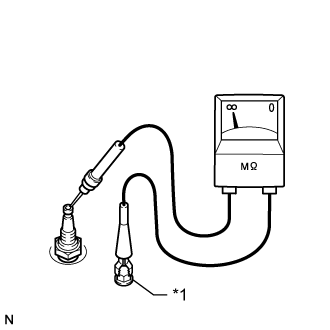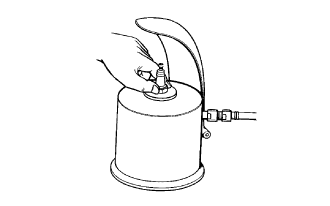Ignition System -- On-Vehicle Inspection |
| 1. PERFORM SPARK TEST |
Check for DTCs (Click here).
- NOTICE:
- If any DTC is output, perform troubleshooting procedures for that DTC.
Check if sparks occur.
Remove the ignition coils and spark plugs (Click here).
Install the spark plug to the ignition coil and connect the ignition coil connector.
Disconnect the 8 injector connectors.
Ground the spark plug.
Visually check that sparks occur while the engine is being cranked.
- NOTICE:
- Be sure to ground the spark plug when checking.
- If the ignition coil has been struck or dropped, replace it.
- Do not crank the engine for more than 2 seconds.
Check that the wire harness side connector of the ignition coil with igniter is securely connected.
Result Result Proceed to NG Connect securely OK Go to next step
Perform a spark test on each ignition coil with igniter.
If there is a cylinder where sparks do not occur, replace its ignition coil with the ignition coil of a cylinder where sparks occur normally.
Crank the engine and visually check that sparks occur at the cylinder with the normally operating ignition coil.
Result Result Proceed to OK Replace ignition coil with igniter NG Go to next step
Check spark plug.
Result Result Proceed to NG Replace spark plug OK Go to next step
Check the power supply to the ignition coil with igniter.
Turn the engine switch on (IG).
Check that there is battery voltage at the ignition coil positive (+) terminal.
Result Result Proceed to NG Check wiring between engine switch and ignition coil with igniter OK Go to next step
Check the VVT sensor for intake side (Click here).
Check the VVT sensor for exhaust side (Click here).
Check the camshaft position sensor (Click here).
Check the crankshaft position sensor (Click here).
Check the IGT signal circuit (Click here).
Connect the 8 injector connectors.
Install the ignition coils and spark plugs (Click here).
| 2. INSPECT SPARK PLUG |
- NOTICE:
- Do not use a wire brush for cleaning.
- Do not attempt to adjust the electrode gap of a used spark plug.
Check the electrode.
Using a megohmmeter, measure the insulation resistance.
- Standard Insulation Resistance:
Tester Connection Condition Specified Condition Spark plug (terminal part) - Body ground Always 10 MΩ or higher
If the insulation resistance is below the specified range, replace the spark plug.Text in Illustration *1 Ground - HINT:
- If a megohmmeter is not available, perform the following simple inspection instead.

Alternative inspection method:
Quickly accelerate the engine to 4000 rpm 5 times.
Remove the spark plug.
Visually check the spark plug.
If the electrode is dry, the spark plug is functioning properly. If the electrode is damp, proceed to the next step.
Check the spark plug for any damage to its threads and insulator.
If there is any damage, replace the spark plug.- Recommended Spark Plug:
Manufacturer Type DENSO made SK20HR11
- HINT:
- Maximum electrode gap for a used spark plug: 1.3 mm (0.0512 in.).
- If the gap is more than the maximum, replace the spark plug.
- Electrode gap for a new spark plug: 1.0 to 1.1 mm (0.0394 to 0.0433 in.).
- NOTICE:
- If adjusting the gap of a new spark plug, bend only the base of the ground electrode. Do not touch the tip. Never attempt to adjust the gap of a used plug.
- Standard air pressure:
- 588 kPa (6.0 kgf/cm2, 85 psi)
- Standard duration:
- 20 seconds or less
- HINT:
- Only use the spark plug cleaner when the electrode is free of oil. If the electrode has traces of oil, use gasoline to clean off the oil before using the spark plug cleaner.
 |